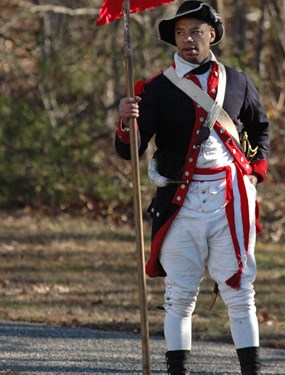
How many minorities were at the Battle of Cowpens? A diverse group of individuals met on the field of battle on a bitterly cold Wednesday morning, January 17, 1781. Of the more than two thousand men who fought this battle, the National Park Service can document fifteen black males who fought with the Americans. In addition, there is one famous black male who the NPS cannot document. Who were the known minorities in the Battle of Cowpens? The names of minorities that the National Park Service can document at the Battle of Cowpens are as follows: Julius Cesar, Lemerick Farr, Andrew Ferguson, Fortune Freeman, Gideon Griffen, Morgan Griffen, Drury Harris, Edward Harris, Allen Jeffers, Berry Jeffers, Osborne Jeffers, Andrew Peeleg, Dick Pickens, and Record Primes (or Primus Record.) Is any additional information available on these people? There is not a lot of additional information available on most of the minorities. However, the information available is interesting. Born in Dinwiddie County, Virginia, Andrew Ferguson was about 15 years old when he fought at the Battle of Cowpens. In his pension application, he stated that he arrived late to the Battle of Kings Mountain. He also said, “While we were at the River Pacolet, the British under Colonel Tarleton came upon us and Colonel [sic] Morgan marched us on towards the Cowpens but before we got there we made a stand and whipped the British completely. This took place I think sometime in the month of January 1781. Immediately after this Battle we started back to North Carolina…” His next battle action was at Guilford Courthouse, where he was wounded in the head. Ferguson settled in Indiana after the war. He died in 1855 and was buried in an unmarked grave. In 1984, the Daughters of the American Revolution placed a marker on his grave. Edward Harris filed a pension application on November 19, 1852 while he was living in Richland District, South Carolina. He stated that he and his parents were free blacks. He served in the 3rd South Carolina Regiment under Captain Richard Brown and Colonel Thompson and was later in the militia. He served in the battles at Savannah, Stono, Charleston, Hanging Rock, Camden, Cowpens, and Eutaw Springs. Harris stated in his pension that along with his cousin Drury Harris, he served with Gideon Griffen, Morgan Griffen, Berry Jeffers, Allen Jeffers, and Osborne Jeffers.Berry and Osborne Jeffers were brothers. Dick Pickens was Andrew Pickens' servant and stayed in the rear during the Battle of Cowpens. Immediately after the battle, he found a "dead" British officer on the battlefield and began to remove his boots because Colonel Pickens needed a new pair. The officer revived somewhat and inquired about what was going on. He acknowledged that he no longer needed the boots, but would like a drink of water. Dick Pickens was happy to swap a drink of water for boots. Primes Record or Record Primus was a free man of color. He applied for a pension December 16, 1846 while residing in Roane County, Tennessee when he was 86 years old. He stated that he enlisted in 1777. Part of the time he served under Captain Garter, Captain Abbott, Captain Locke, and Colonel Williams. At anothertime, he was Colonel Thomas Carson's waiter. He was taken prisoner atCharleston and paroled. He violated his parole and rejoined the army. He was taken prisoner and released again at Gum Swamp. He was wounded in the head at Camden. He stated that he was also in the Battles of Kings Mountain, Cowpens, Guilford Courthouse, Eutaw Springs, and the siege of Yorktown. However, his claim was denied because he did not furnish the required proof of six months service. Is nothing known about Ball/Collins/Collin, Washington's waiter, depicted in the William Ranney painting, "Battle of Cowpens"? The painting shows the famous William Washington - Banastre Tarleton sword fight in which Washington's servant rode up and saved Washington's life by firing a pistol at the British officer. Since most waiters were black, Ranney painted him that way. Apparently the servant did not file a pension, and Washington did not leave behind written papers of his own role or of anyone else's role in the American Revolution. Therefore, the National Park Service cannot document Ball/Collins/Collin. What sources should one use for additional information?
|
Last updated: January 26, 2022
